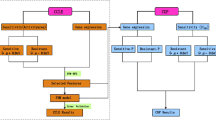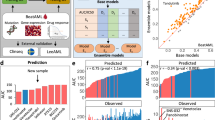Abstract
An important aspect of sustainable drug development is drug-target interaction. In cancer cell lines, the drug response target ratio is critical. It is important to estimate the drug reaction in a cancer cell line. In prior research, we employed ensemble algorithms with voting methods to predict medication response and achieved 97.5% accuracy. A hybrid ensemble algorithm for the revised drug response (HBEA) method is developed to improve drug-target strategy in cell lines. Rather than generating several homogeneous weak learners to generate a single model in the ensemble, this enhanced algorithm uses a diverse collection of weak learners such as random forest, Naive Bayes, and decision tree to create a strong meta-classifier. Cross-validation of hard and soft data would be used to accomplish this. The concentrations of various drugs are used as inputs, and the cell line predicts the relevant drug response. The goal of this enhanced ensemble algorithm is to suggest a new medicine based on a single licensed drug or a combination of drugs. This approach increased the drug responsiveness from 97.5 to 100%, according to our findings. The proposed method is applied in an open-source and freely available at https://decrease.fimm.fi.
Access this chapter
Tax calculation will be finalised at checkout
Purchases are for personal use only
Similar content being viewed by others
References
Ashley EA (2015) The precision medicine initiative: a new national effort. JAMA 313:2119–2120
Collins FS, Varmus H (2015) A new initiative on precision medicine. N Engl J Med 372:793–795
Adam G, Rampášek L, Safikhani Z, Smirnov P, HaibeKains B, Goldenberg A (2020) Machine learning approaches to drug response prediction: challenges and recent progress, NPJ Precis Oncol
Wang L, Li X, Zhang L, Gao Q (2017) Improved anticancer drug response prediction in cell lines using matrix factorization with similarity regularization. BMC Cancer 17:513
Lu X, Gu H, Wang Y, Wang J, Qin P (2019) Autoencoder based feature selection method for classification of anticancer drug response. Front Genet 10:233
Azuaje F (2017) Computational models for predicting drug responses in cancer research. Brief Bioinf 18:820–829
Costello JC et al (2014) A community effort to assess and improve drug sensitivity prediction algorithms. Nat Biotechnol 32:1202
Lee W-H, Loo C-Y, Daniela Traini P, Young M (2015) Inhalation of nanoparticlebased drug for lung cancer treatment: advantages and challenges. Asian J Pharma Sci
Patton JS, Fishburn CS, Weers JG (2004) The lungs as a portal of entry for systemic drug delivery. Proc Am Thorac Soc 1:338–344
Schanker LS, Less MJ (1977) Lung pH and pulmonary absorption of nonvolatile drugs in the rat. Drug Metabol Dispos 5:174–178
Lai Y-H, Chen W-N, Hsu T-C, Lin C, Tsao Y, Semon W (2020) Overall survival prediction of non-small cell lung cancer by integrating microarray and clinical data with deep learning. Sci Rep 10(1):1–11
Doppalapudi S, Qiu RG, Badr Y, Lung cancer survival period prediction and understanding: deep learning
SEER Program (2019) National Cancer Institute (NCI), SEER Incidence Data, 1975–2017. Available https://seer.cancer.gov/data/
Fangfang Xia “A cross-study analysis of drug response prediction in cancer cell lines”, 23(1), 2022, 1–12.
Yıldırım MA et al (2007) Drug—target network. Nat Biotechnol 25:1119
Heba E-B, Attia A-F, Nawal E-F, Torkey H (2021) Efficient machine learning model for predicting drug-target interactions with case study for Covid-19. Comput Biol Chem
Ding H et al (2014) Similarity-based machine learning methods for predicting drug-target interactions: a brief review. Brief Bioinform 15(5):734–747
Nath A, Kumari P, Chaube R (2018) Prediction of human drug targets and their interactions using machine learning methods: current and future perspectives. Methods Mol Biol 1762:21–30
Ezzat A et al (2018) Computational prediction of drug-target interactions using chemogenomic approaches: an empirical survey. Brief Bioinform 20(4):1337–1357
Sachdev K, Gupta MK (2019) A comprehensive review of feature-based methods for drug-target interaction prediction. J Biomed Inform 93:103159
Zhou L et al (2019) Revealing drug-target interactions with computational models and algorithms. Molecules 24(9):1714
Zhang W et al (2019) Recent advances in machine learning-based drug-target interaction prediction. Curr Drug Metab 20(3):194–202
Thafar M, Raies AB, Albaradei S, Essack M, Bajic VB (2019) Comparison study of computational prediction tools for drug–target binding affinities. Front Chem 7:782
Kuncheva LI (2004) Combining pattern classifiers: methods and algorithms. Wiley, Hoboken, NJ
Windeatt T, Roli F (eds) (2003) Multiple classifier systems, in Lecture Notes in Computer Science, vol 2709, Springer
Roli F, Kittler J, Windeatt T (eds) (2004) Multiple classifier systems, in Lecture Notes in Computer Science, vol 3077, Springer
Zhou Z-H (2012) Ensemble methods: foundations and algorithms (Chapman & Hall/CRC data mining and knowledge discovery series). Chapman & Hall/CRC, Boca Raton, FL
Brazil P, Giraud-Carrier C, Soares C (2009) Meta-learning: applications to data mining. Springer, Berlin Heidelberg
Polikar R (2006) Ensemble-based systems in decision making. IEEE Circ Syst Mag 6(3):21–45
Agrawal SM, Narayanan R, Polepeddi L, Choudhary A (2012) Lung cancer survival prediction using ensemble data mining on SEER data. Sci Progr 20(1):29–42
Safiyari A, Javidan R (2017) Predicting lung cancer survivability using ensemble learning methods. Intell Syst Conf (IntelliSys)
Costello JC, Heiser LM, Georgii E et al (2014) A community effort to assess and improve drug sensitivity prediction algorithms. Nat Biotechnol 32(12):1202–1212
Zhang C, Ma Y (2012) Ensemble machine learning: methods and applications, Springer
Lianga G, Fanb W, Luo H, Zhua X (2020) The emerging roles of artificial intelligence in cancer drug development and precision therapy, vol 128, p 110255
Iorio F, Knijnenburg TA, Vis DJ et al (2016) A landscape of pharmacogenomic interactions in cancer. Cell 166(3):740–754
Borg I, Groenen PJF (2005) Modern multidimensional scaling: theory and applications, 2nd edn. Springer, New York
Santini S, Jain R (1999) Similarity measures. IEEE Trans Patt Anal Mach Intel 21(9):871–883
Smith F, Waterman MS (1981) Identification of common molecular subsequences. J Mole Biol 147(1):195–197
Lipman J, Pearson WR (1985) Rapid and sensitive protein similarity searches. Science 227(4693):1435–1441
Gish AW, Miller W, Myers EW, Lipman DJ (1990) Basic local alignment search tool. J Mole Biol 215(3):403–410
Stanfield Z et al (2017) Drug response prediction as a link prediction problem. Sci Rep 7:40321
Yang J, Li A, Li Y, Guo X, Wang M (2019) A novel approach for drug response prediction in cancer cell lines via network representation learning. Bioinformatics
Zhang N et al (2015) Predicting anticancer drug responses using a dual-layer integrated cell line-drug network model. PLoS Comput Biol 11:e1004498
Pedregosa F, Varoquaux G, Gramfort A, Michel V, Thirion B, Grisel O, Blondel M, Prettenhofer P, Weiss R, Durbourg V, Vanderplas J, Passos A, Cournapeau D, Brucher M, Perrot M, Duchesnay E (2011) Scikit-learn: machine learning in python. J Mach Learn Res 12:2825–2830
Hastie T, Tibshirani R, Friedman J (2008) The elements of statistical learning, 2nd edn. Springer, New York/Berlin/Heidelberg
Duda R, Hart P, Stork D (2001) Pattern classification. John Wiley & Sons
Efron B, Tibshirani R (1993) An Introduction to the Bootstrap. Chapman & Hall
Bhardwaj R, Hooda N (2009) Prediction of pathological complete response after Neoadjuvant Chemotherapy for breast cancer using ensemble machine learning, pp 2352–9148
Chen JIZ, Hengjinda P (2021) Early prediction of coronary artery disease (CAD) by machine learning method-a comparative study. J Artif Intell 3(01):17–33
Manoharan S (2019) Study on Hermitian graph wavelets in feature detection. J Soft Comput Paradigm (JSCP) 1(1):24–32
Kening Li, Yuxin Du, Lu Li, Dong-Qing Wei. “Bioinformatics Approaches for Anti-cancer Drug Discovery” , Current Drug Targets, 2019.
Kuenzi BM, Park J, Fong SH, Sanchez KS, Lee J, Kreisberg JF, Ma J, Ideker T (2020) Predicting drug response and synergy using a deep learning model of human cancer cells. Cancer Cell
Anithaashri TP, Rajendran PS, Ravichandran G (2022) Novel intelligent system for medical diagnostic applications using artificial neural network, Lecture Notes on Data Engineering and Communications Technologiesthis link is disabled, vol 101, pp 93–101
Niroomand N, Bach C, Elser M (2021) Segment-based CO emission evaluations from passenger cars based on deep learning techniques. IEEE Access
Prajwal K, Tharun K, Navaneeth P, Anand Kumar M (2022) Cardiovascular disease prediction using machine learning. In: International conference on innovative trends in information technology (ICITIIT)
lanevski A, Giri AK, Gautam P, Kononov A, Potdar S, Saarela J, Wennerberf K, Aittokallio T (2019) Prediction of drug combination effects with a minimal set of experiments, vol 1, pp. 568–577
Baptista D, Ferreira PG, Rocha M (2020) Deep learning for drug response prediction in cancer. Brief Bioinform
Rajendran PS, Kartheeswari KR (2022) Anti-cancer drug response prediction system using stacked ensemble approach, Lecture Notes in Networks, vol 436, pp 205–218
Acknowledgements
This research is funded by the Indian Council of Medical Research (ICMR). (Sanction no: ISRM/12(125)/2020 ID NO.2020-5128 dated 10/01/21).
Author information
Authors and Affiliations
Corresponding author
Editor information
Editors and Affiliations
Rights and permissions
Copyright information
© 2023 The Author(s), under exclusive license to Springer Nature Singapore Pte Ltd.
About this paper
Cite this paper
Rajendran, P.S., Kartheeswari, K.R. (2023). Implementation of HBEA for Tumor Cell Prediction Using Gene Expression and Dose Response. In: Rajakumar, G., Du, KL., Rocha, Á. (eds) Intelligent Communication Technologies and Virtual Mobile Networks. ICICV 2023. Lecture Notes on Data Engineering and Communications Technologies, vol 171. Springer, Singapore. https://doi.org/10.1007/978-981-99-1767-9_46
Download citation
DOI: https://doi.org/10.1007/978-981-99-1767-9_46
Published:
Publisher Name: Springer, Singapore
Print ISBN: 978-981-99-1766-2
Online ISBN: 978-981-99-1767-9
eBook Packages: EngineeringEngineering (R0)




